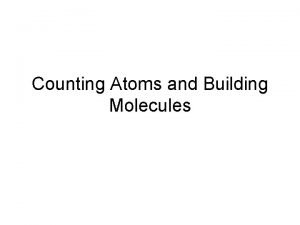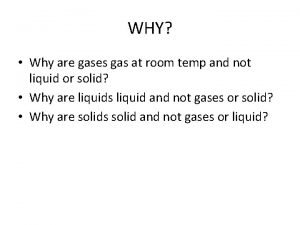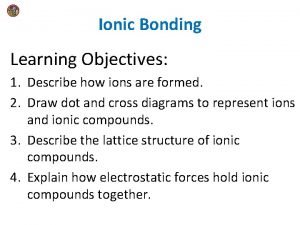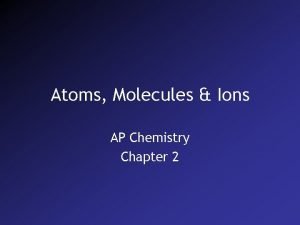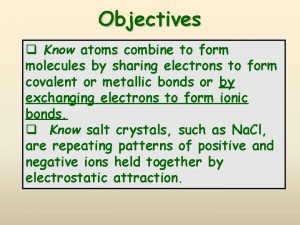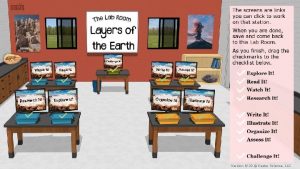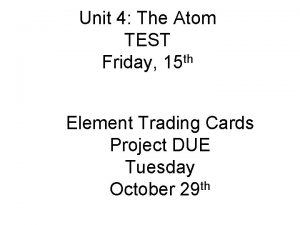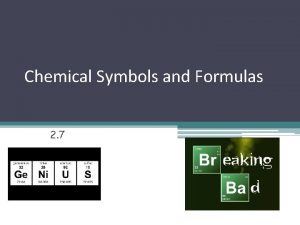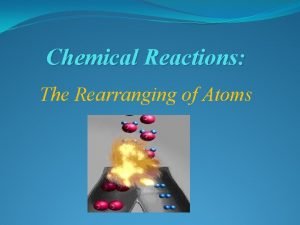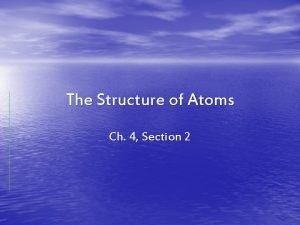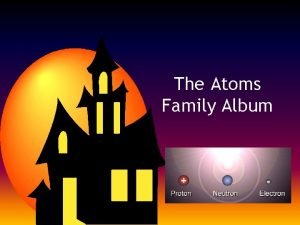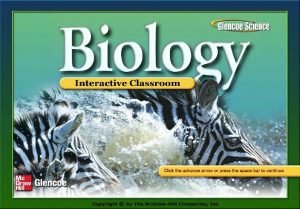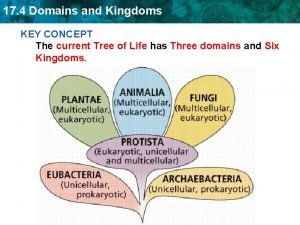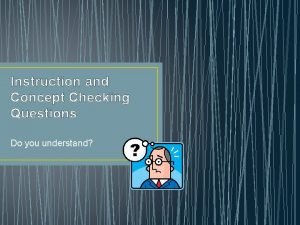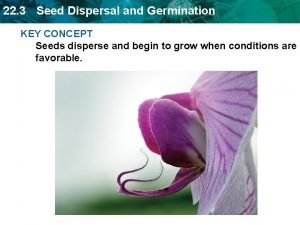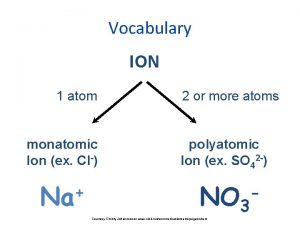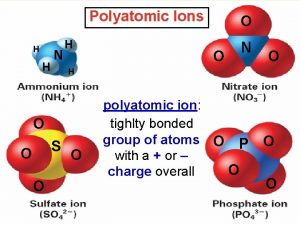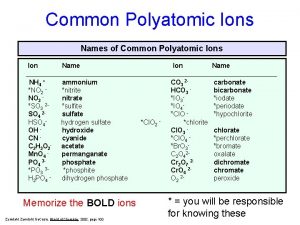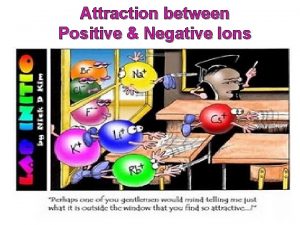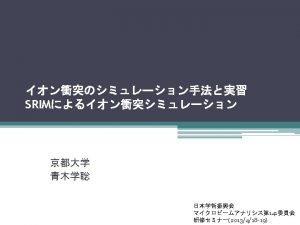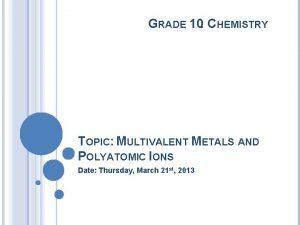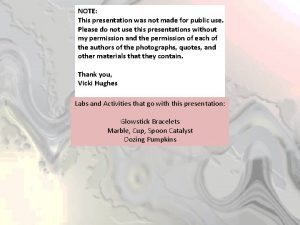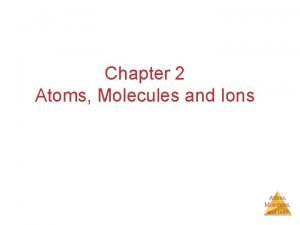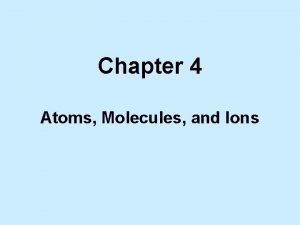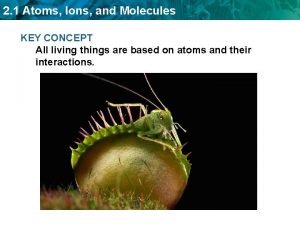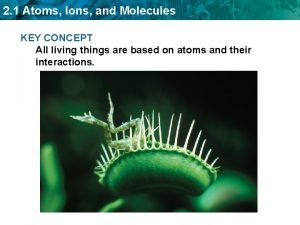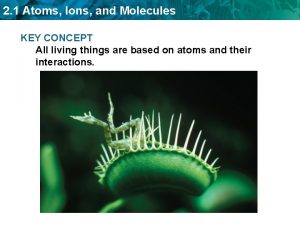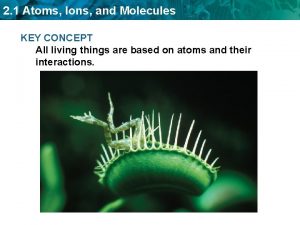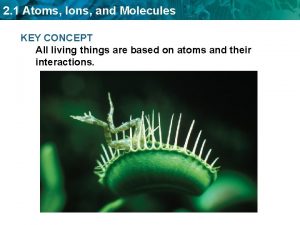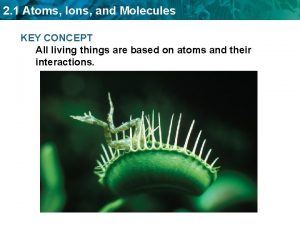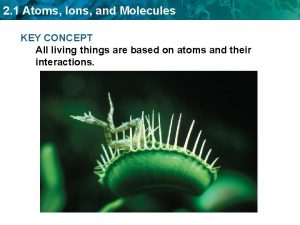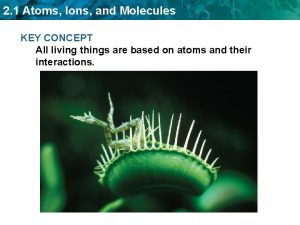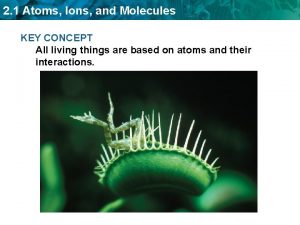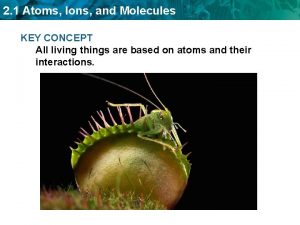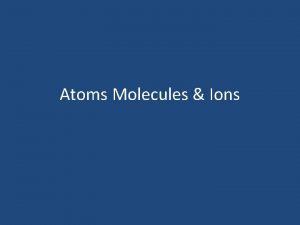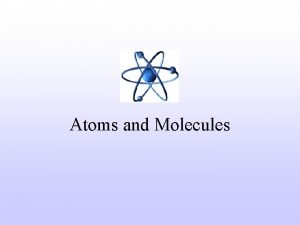2 1 Atoms Ions and Molecules KEY CONCEPT











































- Slides: 43

2. 1 Atoms, Ions, and Molecules KEY CONCEPT All living things are based on atoms and their interactions.

2. 1 Atoms, Ions, and Molecules Living things consist of atoms of different elements. • An atom is the smallest basic unit of matter. • An element is one type of atom. Hydrogen atom (H) H Oxygen atom (O) O

2. 1 Atoms, Ions, and Molecules • An atom has a nucleus and electrons. – The nucleus has protons and neutrons. – Electrons are in energy levels outside nucleus. Oxygen atom (O) Nucleus: 8 protons (+) 8 neutrons outermost energy level: 6 electrons (-) inner energy level: 2 electrons (-)

2. 1 Atoms, Ions, and Molecules • A compound is made of atoms of different elements bonded together. – water (H 2 O) – carbon dioxide (CO 2) – many other carbon-based compounds in living things

2. 1 Atoms, Ions, and Molecules Ions form when atoms gain or lose electrons. • An ion is an atom that has gained or lost one or more electrons. – positive ions – negative ions • Ionic bonds form between oppositely charged ions. gained electron Na loses an electron to CI Sodium atom (Na) Chlorine atom (CI) ionic bond Sodium ion (Na +) Chloride ion (CI -)

2. 1 Atoms, Ions, and Molecules Atoms share pairs of electrons in covalent bonds. • A covalent bond forms when atoms share a pair of electrons. – multiple covalent bonds – diatomic molecules covalent bonds Oxygen atom (O) Carbon atom (C) Carbon dioxide (CO 2 ) Oxygen atom (O)

2. 2 Properties of Water KEY CONCEPT Water’s unique properties allow life to exist on Earth.

2. 2 Properties of Water Life depends on hydrogen bonds in water. • Water is a polar molecule. – Polar molecules have slightly charged regions. _ O H + – Nonpolar molecules do not have charged regions. – Hydrogen bonds form between slightly positive hydrogen atoms and slightly negative atoms.

2. 2 Properties of Water • Hydrogen bonds are responsible for three important properties of water. – high specific heat – cohesion – adhesion

2. 2 Properties of Water Many compounds dissolve in water. • A solution is formed when one substance dissolves in another. – A solution is a homogeneous mixture. – Solvents dissolve other substances. – Solutes dissolve in a solvent. solution

2. 2 Properties of Water • “Like dissolves like. ” – Polar solvents dissolve polar solutes. – Nonpolar solvents dissolve nonpolar solutes. – Polar substances and nonpolar substances generally remain separate.

2. 2 Properties of Water Some compounds form acids or bases. • An acid releases a hydrogen ion when it dissolves in water. – high H+ concentration – p. H less than 7 stomach acid p. H between 1 and 3 more acidic

2. 2 Properties of Water • A base removes hydrogen ions from a solution. – low H+ concentration – p. H greater than 7 bile p. H between 8 and 9 more basic

2. 2 Properties of Water • A neutral solution has a p. H of 7. pure water p. H 7

2. 3 Carbon-Based Molecules KEY CONCEPT Carbon-based molecules are the foundation of life.

2. 3 Carbon-Based Molecules Carbon atoms have unique bonding properties. • Carbon forms covalent bonds with up to four other atoms, including other carbon atoms. • Carbon-based molecules have three general types of structures. – straight chain – branched chain – ring

2. 3 Carbon-Based Molecules • Many carbon-based molecules are made of many small subunits bonded together. – Monomers are the individual subunits. – Polymers are made of many monomers.

2. 3 Carbon-Based Molecules Four main types of carbon-based molecules are found in living things. • Carbohydrates are made of carbon, hydrogen, and oxygen.

2. 3 Carbon-Based Molecules Four main types of carbon-based molecules are found in living things. • Carbohydrates are made of carbon, hydrogen, and oxygen. – Carbohydrates include sugars and starches. – Monosaccharides are simple sugars. – Polysaccharides include starches, cellulose, and glycogen.

2. 3 Carbon-Based Molecules • Carbohydrates can be broken down to provide energy for cells. • Some carbohydrates are part of cell structure. Polymer (starch) Starch is a polymer of glucose monomers that often has a branched structure. Polymer (cellulose) monomer Cellulose is a polymer of glucose monomers that has a straight, rigid structure

2. 3 Carbon-Based Molecules • Lipids are nonpolar molecules that include fats, oils, and cholesterol. – Many contain carbon chains called fatty acids. – Fats and oils contain fatty acids bonded to glycerol. Triglyceride

2. 3 Carbon-Based Molecules • Lipids have several different functions. – broken down as a source of energy – make up cell membranes – used to make hormones

2. 3 Carbon-Based Molecules • Fats and oils have different types of fatty acids. – saturated fatty acids – unsaturated fatty acids

2. 3 Carbon-Based Molecules • Phospholipids make up all cell membranes. – Polar phosphate “head” – Nonpolar fatty acid “tails” Phospholipid

2. 3 Carbon-Based Molecules • Proteins are polymers of amino acid monomers. – Twenty different amino acids are used to build proteins in organisms.

2. 3 Carbon-Based Molecules • Proteins are polymers of amino acid monomers. – Twenty different amino acids are used to build proteins in organisms. – Amino acids differ in side groups, or R groups.

2. 3 Carbon-Based Molecules • Proteins are polymers of amino acid monomers. – Twenty different amino acids are used to build proteins in organisms. – Amino acids differ in side groups, or R groups. – Amino acids are linked by peptide bonds.

2. 3 Carbon-Based Molecules • Proteins differ in the number and order of amino acids. – Amino acids interact to give a protein its shape. Hemoglobin hydrogen bond – Incorrect amino acids change a protein’s structure and function.

2. 3 Carbon-Based Molecules • Nucleic acids are polymers of monomers called nucleotides.

2. 3 Carbon-Based Molecules • Nucleic acids are polymers of monomers called nucleotides. – Nucleotides are made of a sugar, phosphate group, and a nitrogen base. A phosphate group deoxyribose (sugar) nitrogen-containing molecule, called a base

2. 3 Carbon-Based Molecules • Nucleic acids are polymers of monomers called nucleotides. – Nucleotides are made of a sugar, phosphate group, and a nitrogen base. – DNA stores genetic DNA information. – RNA builds proteins. RNA

2. 4 Chemical Reactions KEY CONCEPT Life depends on chemical reactions.

2. 4 Chemical Reactions Bonds break and form during chemical reactions. • Chemical reactions change substances into different ones by breaking and forming chemical bonds. – Reactants are changed during a chemical reaction. – Products are made by a chemical reaction.

2. 4 Chemical Reactions • Bond energy is the amount of energy that breaks a bond. – Energy is added to break bonds. – Energy is released when bonds form. • A reaction is at equilibrium when reactants and products form at the same rate. CO 2 + H 2 O H 2 CO 3

2. 4 Chemical Reactions Chemical reactions release or absorb energy. • Activation energy is the amount of energy that needs to be absorbed to start a chemical reaction.

2. 4 Chemical Reactions • Exothermic reactions release more energy than they absorb. – Reactants have higher bond energies than products. – Excess energy is released by the reaction.

2. 4 Chemical Reactions • Endothermic reactions absorb more energy than they release. – Reactants have lower bond energies than products. – Energy is absorbed by the reaction to make up the difference.

2. 5 Enzymes KEY CONCEPT Enzymes are catalysts for chemical reactions in living things.

2. 5 Enzymes A catalyst lowers activation energy. • Catalysts are substances that speed up chemical reactions. – decrease activation energy – increase reaction rate

2. 5 Enzymes allow chemical reactions to occur under tightly controlled conditions. • Enzymes are catalysts in living things. – Enzymes are needed for almost all processes. – Most enzymes are proteins.

2. 5 Enzymes • Disruptions in homeostasis can prevent enzymes from functioning. – Enzymes function best in a small range of conditions. – Changes in temperature and p. H can break hydrogen bonds. – An enzyme’s function depends on its structure.

2. 5 Enzymes • An enzyme’s structure allows only certain reactants to bind to the enzyme. – substrates – active site substrates (reactants) enzyme Substrates bind to an enzyme at certain places called active sites.

2. 5 Enzymes • The lock-and-key model helps illustrate how enzymes function. – substrates brought together – bonds in substrates weakened Substrates bind to an enzyme at certain places called active sites. The enzyme brings substrates together and weakens their bonds. The catalyzed reaction forms a product that is released from the enzyme.
 Atoms molecules and ions
Atoms molecules and ions Atoms molecules and ions
Atoms molecules and ions Atoms molecules and ions
Atoms molecules and ions Atoms molecules and ions
Atoms molecules and ions Atoms ions and molecules
Atoms ions and molecules Atoms ions and molecules
Atoms ions and molecules States that atoms ions and molecules must collide to react
States that atoms ions and molecules must collide to react Chapter 2 atoms molecules and ions
Chapter 2 atoms molecules and ions Carbon trichloride
Carbon trichloride What is the relationship between atoms and elements
What is the relationship between atoms and elements Compound substance
Compound substance How can you count atoms and molecules
How can you count atoms and molecules Interacting molecules or ions
Interacting molecules or ions Organic molecules vs inorganic molecules
Organic molecules vs inorganic molecules Positive ions are atoms that have
Positive ions are atoms that have Atoms or ions are considered isoelectronic if
Atoms or ions are considered isoelectronic if Why do atoms combine to form molecules
Why do atoms combine to form molecules At stp which substance is the best conductor of electricity
At stp which substance is the best conductor of electricity Chapter 6 chemistry in biology
Chapter 6 chemistry in biology Key concept summaries answer key
Key concept summaries answer key Key concept builder lesson 1 what are waves answer key
Key concept builder lesson 1 what are waves answer key Kesler science answer key
Kesler science answer key The atoms family atomic math challenge answer key
The atoms family atomic math challenge answer key Counting atoms worksheet
Counting atoms worksheet Atoms rearranging
Atoms rearranging Chapter 4 section 2 the structure of atoms
Chapter 4 section 2 the structure of atoms Matterville
Matterville Business model
Business model Business model canvas tripadvisor
Business model canvas tripadvisor An ideal self must not deviate from real self
An ideal self must not deviate from real self Pengertian marketing concept
Pengertian marketing concept Amphibia characteristics
Amphibia characteristics 4 kingdoms of life
4 kingdoms of life What is ccqs
What is ccqs Seed and key concept
Seed and key concept Monatomic ion
Monatomic ion Polyatomic ion charges
Polyatomic ion charges Ionic compounds list
Ionic compounds list Variable charge cations
Variable charge cations Electrostatic attraction between positive and negative ions
Electrostatic attraction between positive and negative ions Srim the stopping and range of ions in matter
Srim the stopping and range of ions in matter What element
What element Freezing point chapter 13
Freezing point chapter 13 Chemical formulas list for class 10
Chemical formulas list for class 10











